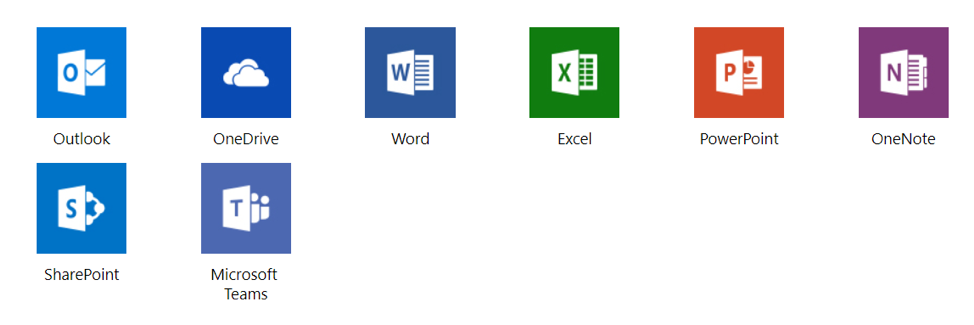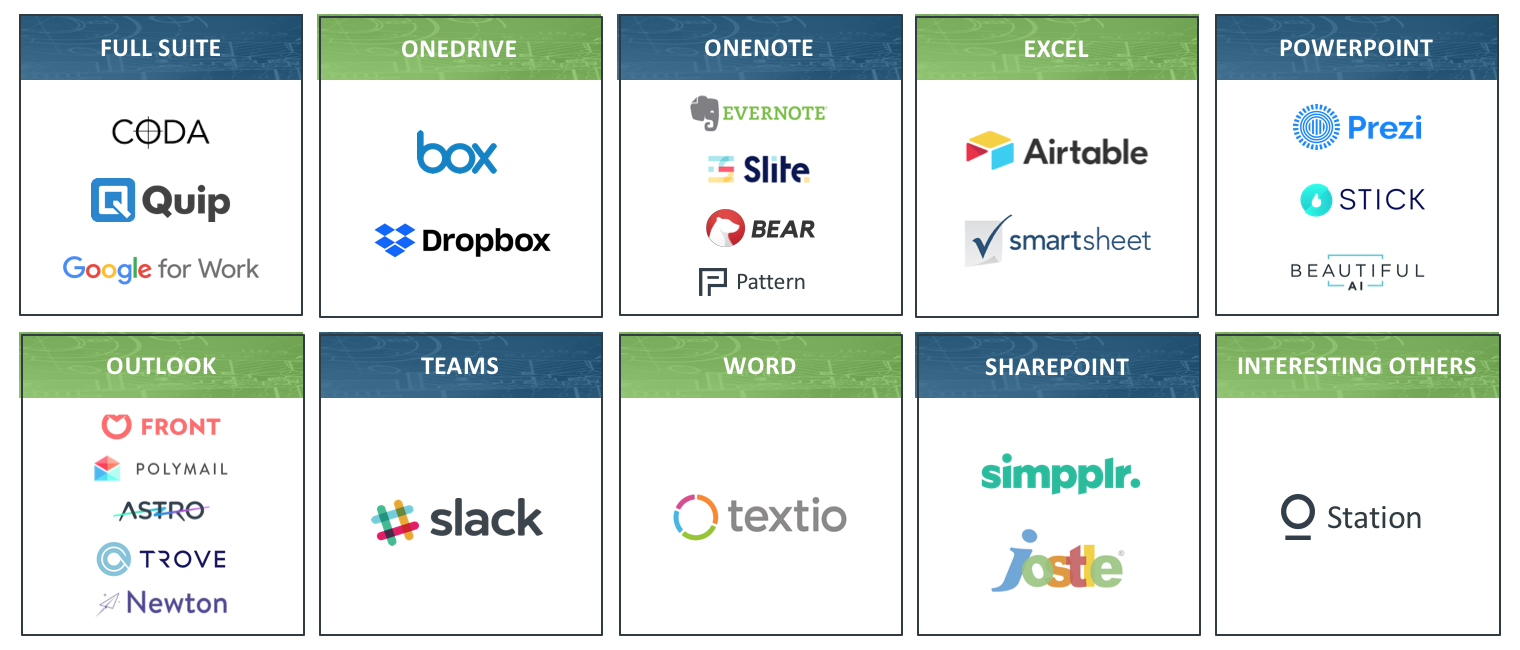Microsoft Office is a suite of productivity tools that help us get work done. Many people would argue that it is one of the most important productivity suites we have. For example, I’m currently writing this blog post in Microsoft Word. We build all of our financial models in Excel and I spend many hours a day reviewing pitch presentations built in PowerPoint. Microsoft has been the market leader in business productivity market for 30 years, but we’ve seen very little innovation in their core products. Over the last few years, we’ve started to see startups pop up to challenge Microsoft and the potential for these startups is huge. Currently, the Microsoft Office suite generates $25bn in annual revenue. Even if a startup were to take just a small part of the market, it could be a multi-billion opportunity.
Current Suite of Microsoft Office Applications:

Let’s look at a brief history of one of Microsoft Office’s most successful products, Microsoft Word, to see if we can learn about what the next wave of productivity software might look like. (Note, if you are a history buff and want to get into detail on the full history of writing software, check out this stellar article by Textio.)
History of Microsoft Word
Let’s start with WordPerfect. Prior to Microsoft Word, WordPerfect had 70% market share of the word processing market. It was revolutionary because it had many more features than the typewriter that came before it. With WordPerfect, you could move text around, check your spelling, and add text formatting through the use of special codes. Game-changing relative to the typewriter.
In the 1990’s, we were introduced to the GUI, which brought on a big disruption at the time – WYSIWYG (what you see is what you get). Instead of writing formatting codes in WordPerfect, business users were introduced to Microsoft Word’s GUI interface that allowed you to easily format a page that would print exactly how it looks on the screen. Users could also add graphics and tables. Microsoft then took 90% of the word processing market.
The mid-2000’s was the collaboration era. Google ran with it and brought the cloud and collaboration into word processing via Google Docs. With Google Docs, employees could work on the same document at the same time and as a result, Google started taking market share from Office, especially on the low end of the market. G Suite as a whole is roughly only 10% the size of Office but gaining traction. In response to G Suite, Microsoft released Office 365 in 2011, which offers similar collaboration functionality.
I drew 2 conclusions from this history lesson. 1) A shift in how we do work could provide an opening for startups to come in and disrupt incumbents. 2) For a startup to be competitive with an incumbent, it has to bring new, killer features that dramatically improves our productivity at work.
So what’s next? What will drive future disruption? There are a few pervasive trends that could bring a new era of productivity software.
+ AI
AI has been a dominant buzzword in the last couple of years for a reason. AI has been beneficial to business users because it improves productivity by automating tedious tasks. We’re just starting to see this enter productivity software. For example, Astro, an email and calendar app, will help prioritize your emails. Astro aims to disrupt Outlook through more intelligent email.
AI can also help business users become more effective at work. Our portfolio company, Textio, uses machine learning to recommend words or phrases to quantitatively improve the performance of a document. Textio helps recruiters expand their recruiting funnel by helping companies choose the right words to use in job postings to attract the broadest base of talent. Companies that use Textio see more candidates and more diversity, which makes the recruiter’s job so much easier. In the future, Textio plans to expand into additional business use cases. Textio plans to disrupt Microsoft Word by using ML to help business writers become more effective.
New User Interface – Voice
I’ve written about this before, but voice could potentially be a game-changer in the workplace. Using voice could result in productivity gains as it’s much faster to speak something than it is to type. It’s early days but we’re curious what productivity in the voice era will look like and what new tools we’ll see that will make it easier for us to do work using voice as an input. A company we’ve seen that could potentially disrupt Notes is Voicera. Eva, Voicera’s AI assistant, takes notes for you and will create a list of action items for you. Why would anyone take notes if the machine can accurately do it for you?
Making things more user friendly
Sometimes, all it takes is simplicity to build a disruptive tool. We’ve seen a few companies that are tackling the Office market by improving some of their core products. Beautiful and Stick.ai, both PowerPoint competitors, are making it easy to create beautiful slides. Typically, professional quality slides require a lot of time and extensive PowerPoint knowledge. Beautiful and Stick created slide/graphic templates that make it easy for inexperienced users to create professional-quality slides, making it easy to create visuals for your ideas.
Coda is another example where ease of use is front and center. Coda takes the spreadsheets and docs we’re familiar with and combines it into one true platform. This is a pain point for many Office users. TBD on whether this will resonate with users but they’re off to a good start.
Clearly there is an opportunity to disrupt the giant. The combination of trends and a slow to move incumbent give way for a new area of productivity tools. In the following market map below, I’ve listed some additional companies that are tackling Microsoft Office. Anyone missing? Let me know at susan@scalevp.com
